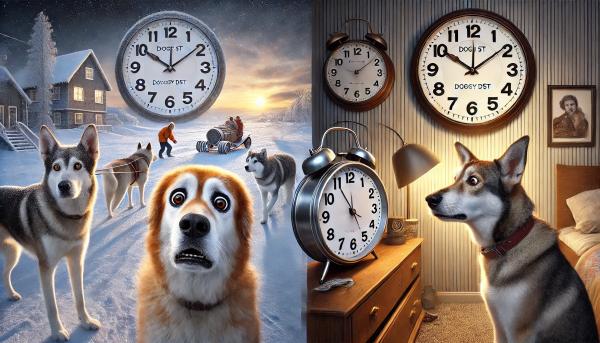
Daylight Saving Time (DST) represents a significant human-induced disruption to natural light patterns, impacting circadian rhythms. Much digital ink is offered as we spring forward and leap back, decrying the rise in accidents that befall humans. A study in PLOS One asks whether the switch to DST in the fall affects our canine friends.
Dogs are closely attuned to human behaviors; there is a price to pay for being “man’s best friend.” Many dog owners have discovered that the master-dog relationship may be overstated to the extent that previous research has shown that dog activity often influences human wake-up time more than the reverse – my Loki likes to get an early start on the day. Loki also tends to stay up late, although given that I am asleep by nine, that is not a difficult task. But I digress; the point is that we entrain with our dogs, and they with us. How, then, does the DST switch impact them?
The study involved two groups of dogs, 25 sled dogs and 37 companion Huskies and malamutes chosen to minimize breed-specific behaviors. Activity was measured by accelerometers attached to dog collars or human wrists for the 7 days before and after “falling back” one hour. The activities measured were those of the dog 30 minutes before and after the sled dog’s handlers arrived or, in the case of companion dogs, the 30 minutes before and after their human got out of bed. Additionally, the activity of the dogs in the 30 minutes before and after sunrise was also measured. The three days following the DST transition activity were compared to pre-transition averages.
Results
- Sled dogs showed elevated morning activity on DST Sunday but returned to normal by DST2, indicating a one-day adjustment. This is similar to the effect observed in drug-detecting dogs adjusting within a day to the new time when returning from their version of an extended vacation.
- Companion dogs exhibited no change in morning onset activity following DST. Neither the sex of the dogs nor the presence of other dogs in the household influenced morning activity levels or changes following DST. One theory is that the presence of multiple household caregivers requires greater flexibility. I personally believe it is because they just do as they please.
- Morning activity in both sled and companion dogs did not align with sunrise times.
While diurnal mammals typically have sleep-wake cycles governed by light through melatonin, companion dogs’ activities were more closely aligned with human routines rather than environmental cues—similarly, outdoor sled dogs based their morning activity on handler schedules instead of sunrise times.
The researchers raised the idea that sled dogs housed in same-sex enclosures likely synchronize their morning activities through group cues, further reinforcing their schedules. They also noted that, like humans, dog activity generally decreases with age. They may also be less responsive to our presence, something Juno, my older dog, is a master of.
This study demonstrates that Daylight Saving Time (DST) has a differential impact on sled and companion dogs. Sled dogs quickly adjust their morning activity in response to DST, aligning with their handlers' schedules, whereas companion dogs maintain consistent activity levels despite changes in caregiver wake-up times. The lack of alignment between dog activity and sunrise times in both groups suggests that human routines play a more significant role in regulating canine behavior than natural light cues.
Source: The Impact Of Daylight Saving Time On Dog Activity PLOS One DOI:10.1371/journal.pone.0317028



